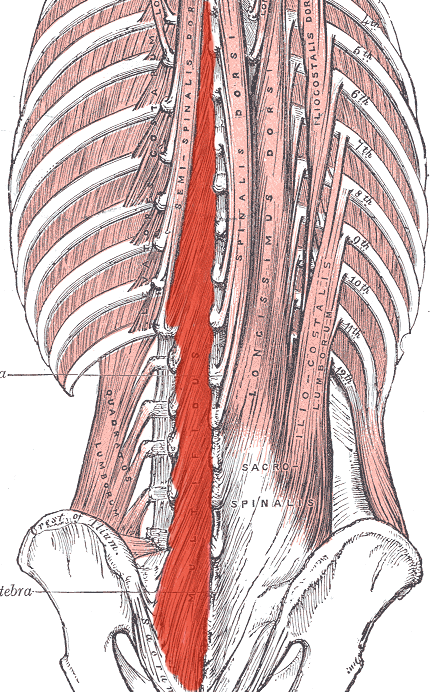The purpose of this blog is to describe the anatomy and function of the lumbar multifidus, and discuss the “best” exercises for training the multifidus.
Do you have new, lingering, or recurring low back pain that’s stopping you from doing the things you enjoy or keeping you from feeling like yourself? Check out our Low Back Resilience Program!
Multifidus Anatomy & Function
Although the multifidi (plural) extend from the sacrum to the cervical spine, they are most prominent in the lumbar spine. They are among the deepest of the muscles in this region and considered part of the transversospinales group that typically span from the spinous processes to the transverse processes. The multifidi also attach to the mamillary processes of the lumbar spine, facet joint capsules, iliac crest, and sacrum as they span 2-5 segments to attach to the spinous processes in a caudolateral direction. It might be helpful to think of their orientation like that of a Christmas tree.
According to Bogduk, they are designed to act on a single spinous process which is supported by the fact that fascicles acting on a given vertebra are innervated by the nerve of that segment. Bergmark introduced the concept of the global and local systems contributing to stability of the lumbar spine and classified the multifidi as part of the local system providing segmental stability.
Actions of the multifidi include extension (bilateral contraction), ipsilateral lateral flexion (unilateral contraction), contralateral rotation (unilateral contraction), and compression. They are also typically described as anti-rotators of the lumbar spine, but Bogduk argues that they are more important for aiding in pure axial rotation by resisting the flexion action of the obliques.
Best Multifidus Exercises
What are the best exercises for training the multifidus? Well, probably one of the most commonly prescribed is the bird dog exercise because there is a component of anti flexion and anti rotation as you’re holding that position. However, Souza and colleagues in 2001 concluded “that the intensity of muscle recruitment [during the bird dog] was not sufficient to provide a strengthening effect in healthy subjects” even when cuff weights were applied to the arm and leg. Ekstrom and colleagues in 2007 found similar low levels of EMG activity in the multifidus during the bird dog and other common rehab exercises such as the bridge, unilateral bridge, and side plank. And a study by Danneels et al. in 2001 demonstrated that low level stabilization exercises don’t actually produce hypertrophy in the multifidus.
The research does consistently show that weighted compound exercises like deadlifts and squats outperform these other movements. Even squats and deadlifts at 50% of your 1 rep max. A systematic review in 2013 by Martuscello and colleagues further reinforced this by stating that “The major findings of this review with moderate levels of evidence indicate that lumbar multifidus EMG activity is greater during free weight exercises compared with ball/device exercises.”
Practical Recommendations
Based on this research, what are my practical recommendations?
If you want to train the multifidus, you don’t have to look much further than barbell deadlifts and back squats. I do recognize that not everyone wants to perform these movements and that’s okay. It’s more about understanding the biomechanics of these exercises and knowing that relatively heavy movements that challenge lumbar extension will be probably be sufficient for activating the multifidus.
You could do barbell back squats and deadlifts, or perhaps romanian deadlifts, barbell bentover rows, and other similar exercises. In most cases, heavy compound exercises are my preference because they are time efficient, easy to objectively measure and progress, and as Martuscello points out – “have multiple health and fitness benefits such as improving body composition, muscular strength, bone density, and cardiovascular health” compared to something like a bird dog. Now, you absolutely can still perform more isolated exercises that may have some of their own unique benefits depending on your goals, but just make sure they’re sufficiently challenging. Great options include reverse hyperextensions, back extensions on a roman chair or GHD, pallof presses, medicine ball throws, or some variations of these.
The multifidus gets a lot of attention in the rehabilitation space because of changes in its structure and function associated with low back pain, but I don’t necessarily think you need to take an overly complex approach in trying to restore that structure and function. I’m not saying that you can’t perform bird dogs or other lower level exercises, or saying that they haven’t helped you or others in the past, but simple, progressive exercises through various movements and ranges of motion will adequately challenge the motor control, stability, strength, etc. of the multifidus.
And the very last thing to point out is that trying to strengthen a singular muscle shouldn’t be the focus for people with low back pain anyway because low back pain is complex and multifactorial. Pick exercises that are sustainable that complement your goals and help you return to your meaningful activities.
Don’t forget to check out our Low Back Resilience Program!
Want to learn more? Check out some of our other similar blogs:
Disc Herniations, Lumbar Stenosis, Core Activation: Instability Isn’t Necessary
Thanks for reading. Check out the video and please leave any questions or comments below.







